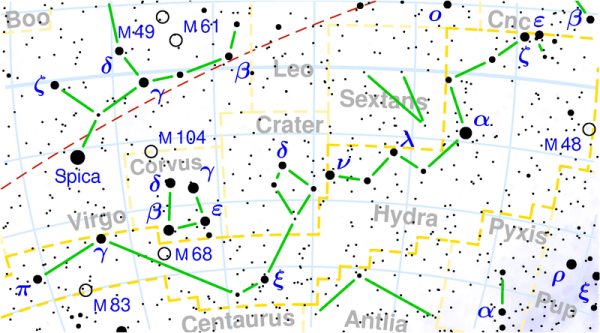Hydra (constellation) (original) (raw)

Hydra. © 2003 Torsten Bronger.
Hydra (abbreviation: Hya), the Water Serpent, is the largest constellation of all (following the dismantling of Argo Navis), stretching across a huge swathe of the southern sky. See below for details of the constellation's brightest stars and interesting deep sky objects.
| Stars brighter than magnitude 4.0 | ||||||
|---|---|---|---|---|---|---|
| star | vis mag | abs mag | spec type | distance (ly) | RA (h m s) | Dec (° ' ") |
| Alpha (Alphard) | 1.99 | -1.69 | K3III | 177 | 09 27 35 | -08 39 31 |
| Gamma | 2.99 | -0.55 | G8IIIa | 132 | 13 18 55 | -23 10 17 |
| Zeta | 3.11 | -0.22 | G8III | 151 | 08 55 24 | +05 56 44 |
| Nu | 3.11 | -0.03 | K0III | 139 | 10 49 37 | -16 11 37 |
| Pi | 3.25 | 0.75 | K2III-IIIbCN | 101 | 14 06 22 | -26 40 56 |
| Epsilon | 3.38 | 0.29 | G0III | 135 | 08 46 47 | +06 25 07 |
| Xi | 3.54 | 0.55 | G8III | 129 | 11 33 00 | -31 51 27 |
| Lambda | 3.61 | 0.88 | K0IIICN | 115 | 10 10 35 | -12 21 15 |
| Mu | 3.83 | -0.58 | K4.5III | 248 | 10 26 05 | -16 50 11 |
| Theta | 3.89 | 0.90 | B9.5V | 129 | 09 14 22 | +02 18 51 |
| Other objects of interest | ||
|---|---|---|
| name | type of object | notes |
| Ghost of Jupiter | planetary nebula | NGC 3242. See separate entry |
| M48 (NGC 2548) | open cluster | On the boundary of Hydra and Monoceros and at the edge of naked-eye visibility. Magnitude 5.8; diameter 54'; RA 08h 13.8m, Dec –05° 48' |
| M68 (NGC 4590) | globular cluster | Discovered by Pierre Méchain in 1780. Magnitude 8.2; diameter 12'; distance 39,000 light-years; RA 12h 39.5m, Dec –26° 45' |
| M83 (NGC 5236) | galaxy | A face-on type Sc spiral just outside the Local Group. Magnitude 8.2; distance 8.5 million light-years; RA 13h 37.0m, Dec –29° 52' |

